Stable and productive cherry Valery Chkalov: description of the variety and features of its cultivation
Cherry variety Valery Chkalov is characterized by resistance to unfavorable climatic and weather conditions, early and rich yield. The fruits of the tree are sweet, juicy, large in size. This is the reason for the popularity of the variety among farmers and gardeners. However, in order to obtain a bountiful harvest, it is important to take into account the peculiarities of the culture, to follow the rules for planting and caring for a tree.
The content of the article
Description of the cherry variety Valery Chkalov
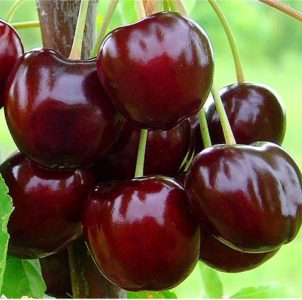
Cherry Valeriy Chkalov is an early variety that is grown in many regions of Russia. Its unpretentiousness, adaptability to various natural conditions make it possible to plant crops not only in the southern territories, but also in the northern regions of the country.
Sweet cherries are frost and drought resistant. Flowering begins in May, fruiting in mid-June. The berries are large and sweet. The tree bears a harvest annually - up to 60 kg of fruits in warm regions. The first berries should be expected at 5 years. The volume depends on the natural conditions and the age of the plant. Over the years, the yield increases, the taste of the fruit increases.
History of origin and distribution
Variety Valery Chkalov was bred by domestic breeders of the Central Laboratory of Genetics. Michurin and Melitopol Gardening Station named after M.F.Sidorenko. With free pollination of the Caucasian Pink Cherry, seedlings of a new variety appeared, which was named in honor of the pilot Valery Chkalov.
The variety was introduced into the State Register in 1974 and zoned in the North Caucasus region. Due to its unpretentiousness, the culture quickly became popular and spread to other regions of the country.
Characteristics and description of trees
A tall tree reaches a length of 3.5 to 6 m. The trunk is strong, stocky with branched branches extending at an angle of 45-60 °. The bark is dense, gray-brown in color. The tree looks massive, has a dense, spreading crown. The size of the leaf is about 19 cm long, 10 cm wide.
During the flowering period, the amount of foliage increases, pink-cream flowers with a pleasant aroma appear. A developed crown is the key to a bountiful harvest. At the same time, gardeners note not only the fruiting, but also the decorative qualities of the culture.
Resistant to temperatures
Cherry Valery Chkalov prefers a warm and mild climate, but it is characterized by resistance to low temperatures, including sudden changes. The frost-resistant culture can withstand up to -30 ° C.
Attention! With a significant or sharp drop in temperature, up to 70% of the buds die, but a third of the crop is usually preserved.
To enhance cold resistance, the culture is prepared for winter.
Moisture and drought resistance
Variety Valery Chkalov needs moderate moisture. Sweet cherry does not like excess liquid, but excessive dryness also reduces the quality of the crop - the berries become less juicy, crumble ahead of time.
When watering, it is recommended to be guided by the meteorological conditions and the climate of the territory - the soil should not dry out or become waterlogged.
Disease and pest resistance
Sweet cherry is susceptible to disease, therefore, it needs additional support and prevention. However, it is resistant to the most dangerous fungal pathologies - moniliosis and coccomycosis.
Planting treatments significantly reduce the risk of pest exposure and disease development.
Characteristics and description of berries
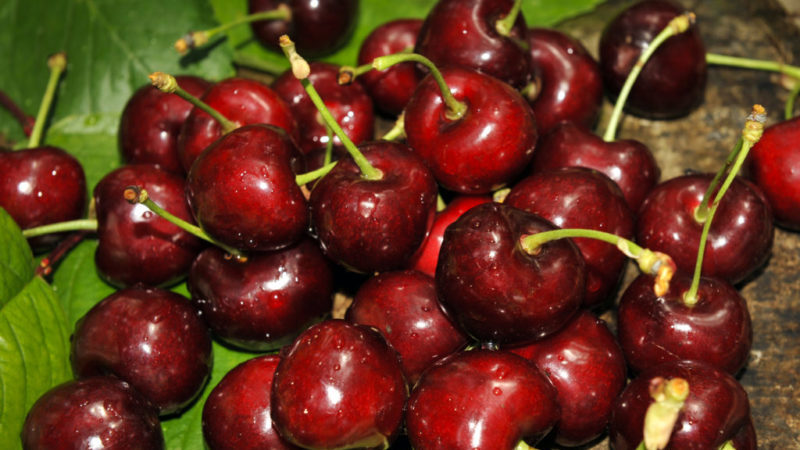
The fruit of the tree is dark red in color, the shape is round, heart-shaped. Berry weight - 6-8 g, seeds - 0.4 g. Fruits are characterized by juiciness, release of juice when damaged. The taste is sweet with sourness.
Sufficient density of berries contributes to their long-term storage and transportation without damage.
Areas of use
Fresh sweet cherries are used as a delicious and healthy dessert. Also, the fruits are used for cooking:
- jam, jam;
- juice, fruit drink;
- wines, tinctures, liqueurs;
- sweets (marmalade, sweets);
- baking fillings.
For long-term preservation, the berries are frozen.
Advantages and disadvantages of the variety
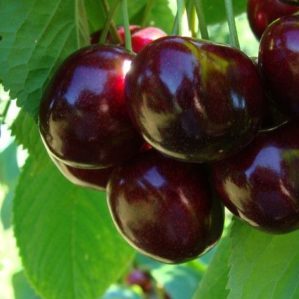
Pros of the Valery Chkalov variety:
- early ripening of berries;
- abundant productivity;
- resistance to cold;
- quality and taste of berries.
Cons of the variety:
- careful care of the crop (preparation for winter, pest control);
- susceptibility to disease;
- self-fertility - pollinators are required to obtain a crop.
Growing technology
Despite the unpretentiousness of the culture, the fruiting of a tree depends on the correctness of its landing and growing conditions.
Optimal conditions
A mild, warm climate is considered beneficial for cherries. She is provided with an abundance of sun, the absence of drafts and a close location of groundwater.
Terms and rules of landing
The best time for planting cherries is early spring (before the buds swell). Rooting it before the arrival of cold weather. During the spring and summer, the culture has time to take root on the site.
The place is chosen sunny and without drafts, in the southern part of the garden, preferably on a hill. The hill can be created artificially. Groundwater should be at a depth of 3-4 m.
Attention! Sweet cherry has a dense crown and a branched root system, so the tree is located at a distance of 5-6 m from buildings and other plants.
Do not plant next to cherries:
- peppers, tomatoes, eggplants - due to the risk of disease damage to the culture;
- oak, linden, birch - due to overdeveloped rhizomes.
When planting, it is important to choose the right stalk - smooth, strong, without delamination, damage, with a developed root system (20-25 cm) and bright foliage. The recommended age is 1-2 years.
Landing rules:
- Before the cold weather comes, dig holes in which to mix humus and soil.
- In the spring, before planting the shoot, loosen the earth, add potassium, magnesium, ash.
- In the middle of the hole (70 × 70 cm in size and 1.5 m deep) place a stake to which to attach the handle.
- Before planting, hold the root in a solution of water and growth stimulant ("Kornevin").
- Place the seedling in the hole, sprinkle with soil, tamp.
- Form an earthen roller around the cutting.
- Water the planting with 2 buckets of water (not cold).
When planting a group of cherries, the distance between the trees is at least 3 m, between the rows - 4 m.
Further care
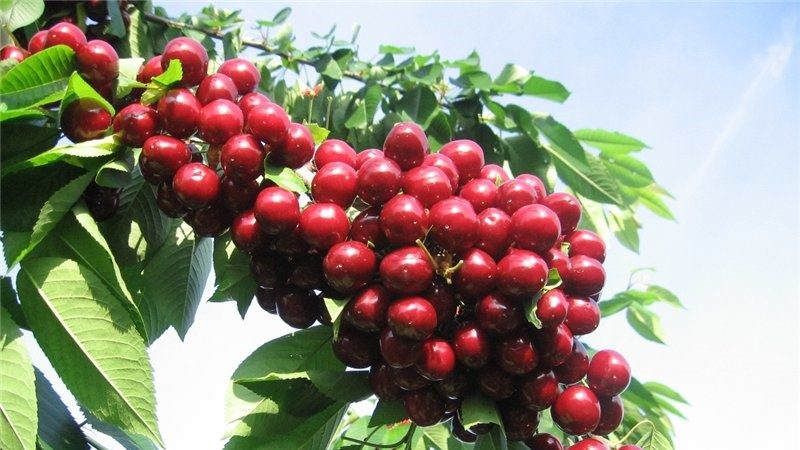
Since the hole with the seedling is fertilized when planting, feeding is not required at first. A year later, substances with a nitrogen content (urea) are added. The plant is fed three times per season.
Care also includes pruning the crown:
- Classic. One main and 5-6 skeletal branches. The height of the tree in this case is 8-9 m.
- Shrub. In the first year, the cherries are cut to 50-60 cm. The next spring, the length of the branches is reduced by 1/5. Vertical shoots are pulled out at right angles, dry shoots are removed. The height of the tree will be up to 2-3 m, but this will not affect the harvest.
Water the culture regularly:
- before and after flowering;
- 2 weeks before picking berries;
- in the middle of autumn before the arrival of cold weather.
During the ripening period, the cherry should not be watered. This can cause cracks in the berries.
Possible problems, diseases, pests
In case of violations in the care, cherries can be affected by diseases and pests.
Cherry pests:
- The cherry slimy sawfly is a leaf-eating larva. Destroy it by spraying with drugs "Aktara" or "Confidor".
- Trubokvert is a beetle with a long proboscis, gnawing branches, leaves, fruits. Requires processing of planting and soil "Inta-vir" or "Fufanon".
- Black aphids are bugs that cause foliage to dry out and fall off. To combat them, remove all ants from the site, shower the trees with tobacco dust, or use Fitoverm.
- The cherry fly lays eggs in the fruit, from which worms form. The tree is treated with an infusion of onion peels, sticky traps for flies are hung.
Hole spot
Brown spots appear on the leaves, in the place of which holes are subsequently formed. Treatment consists in removing diseased shoots - they are burned. The trunk circle is dug up, the tree is sprayed with a solution of Bordeaux mixture (3%).
Moniliosis
Formations with fungal spores appear on the plant, the berries rot, the leaves turn yellow. The disease is developing rapidly. Affected branches are removed from the tree. Means for treatment - copper sulfate, Bordeaux liquid.
Coccomycosis
A pink bloom appears on the lower area of the sheet, blotches on the upper. Then holes are formed, the tree weakens, the foliage falls off. Treatment includes the elimination of the affected branches, spraying with Bordeaux liquid, copper oxychloride.
It is interesting:
The sweet cherry variety "Iput" adored by many gardeners.
The best varieties of cherries for the Moscow region and a guide to their selection.
Wintering
To enhance cold resistance, cherries are prepared for wintering:
- watered abundantly in the trunk circle;
- spud and whitewash the trunk;
- mulch the soil with humus;
- cover the trunk and part of the branches with burlap, insulate with peat.
For young crops, a frame is formed on which agrofibre or burlap is pulled. In the spring, when the snow melts, it is removed.
Reproduction
An effective way to propagate cherries is grafting. The seed method and the rooting of cuttings are impractical.
The culture is grafted into a related or belonging to the same species. For cherries, this is the genus of Plum, which also include cherry, plum, cherry plum. But you can plant cherries on cherries, for example, on another variety. In this case, you do not need to plant pollinating trees.
Features of cultivation depending on the region
Recommended areas with optimal conditions for growing crops:
- Stavropol region;
- North Caucasus;
- Ingushetia;
- Rostov region;
- Krasnodar region.
However, in other regions, planting of the Valery Chkalov variety is allowed. Under favorable conditions (for example, in the Crimea) the yield reaches 60 kg. To the north, it falls 2-3 times. In less stable areas, more careful tree care and preparation for wintering are required.
Pollinating varieties
Since the Valery Chkalov variety is self-fertile, planting of pollinators is required:
- Early ripening;
- Zhabule;
- April;
- June early;
- Bigarro Burlat;
- Rechitsa;
- Poetry.
How is pollinated
Cherry yield Valery Chkalov depends on the pollinators located nearby. They are planted at a distance of 3-4 m from each other. It is important for effective pollination that crops have identical flowering periods.
Attention! To save space on the site, it is permissible to plant several different varieties on one tree.
Gardeners reviews
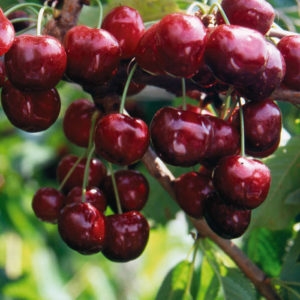
Gardeners from different regions are satisfied with the proven cherry variety Valery Chkalov.
Tatiana Smirnova, Sevastopol: “Since the climate in my region is favorable, Valery Chkalov had no problems with the adaptation of the sweet cherry variety. The tree did not require special care, only standard procedures. The berries appeared in the fifth year - large, sweet. "
Ekaterina Poletaeva, Vladimir: “Valery Chkalov did not immediately decide to plant cherries because of the unstable weather. But worried in vain.Young trees did not suffer during the winter. I was preparing for wintering - I covered the cuttings well. The harvest appeared in a few years. "
Victor Litvinov, Kirishi: “Valery Chkalov cherries have been growing on my site for 7 years already. It is resistant to disease and cold. The neighbors are also growing, no problems are noted. I have a tree about 4 m tall, in spring it blooms very beautifully, the berries are large and fragrant. "
Conclusion
Cherry Valery Chkalov has earned the recognition of gardeners. Planting a culture and caring for it does not cause difficulties and even gardeners without experience can do it. Variety will delight you with a bountiful harvest, large and juicy berries. The life span of a tree with proper care reaches more than 10 years.